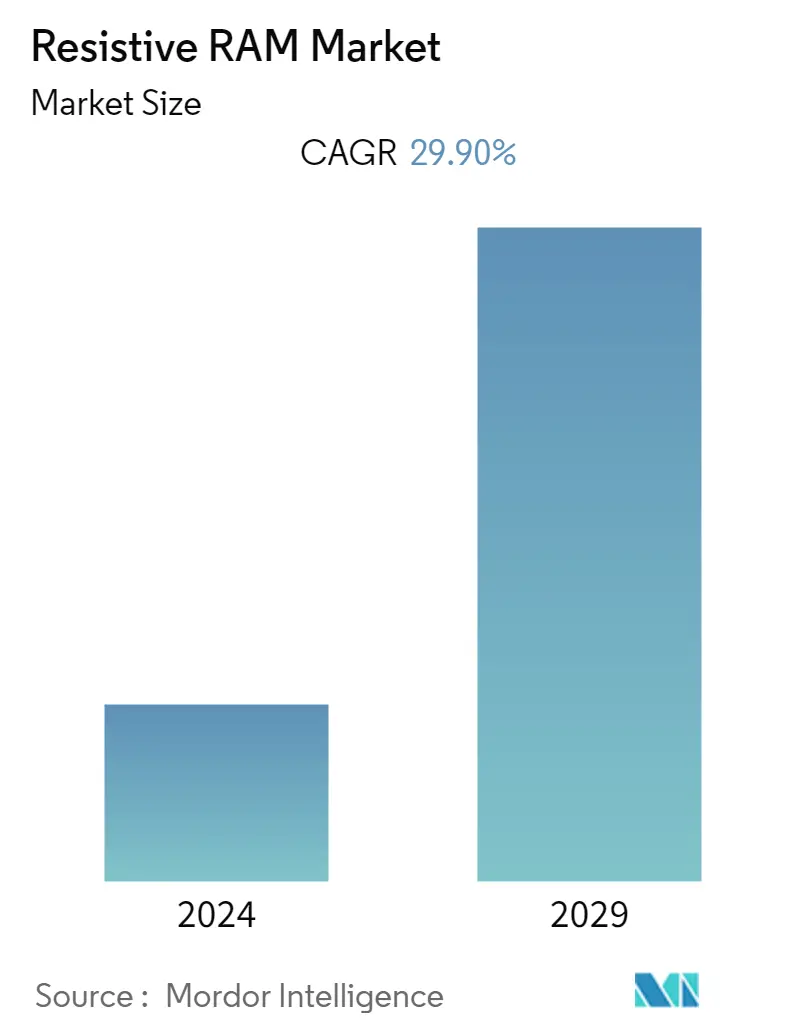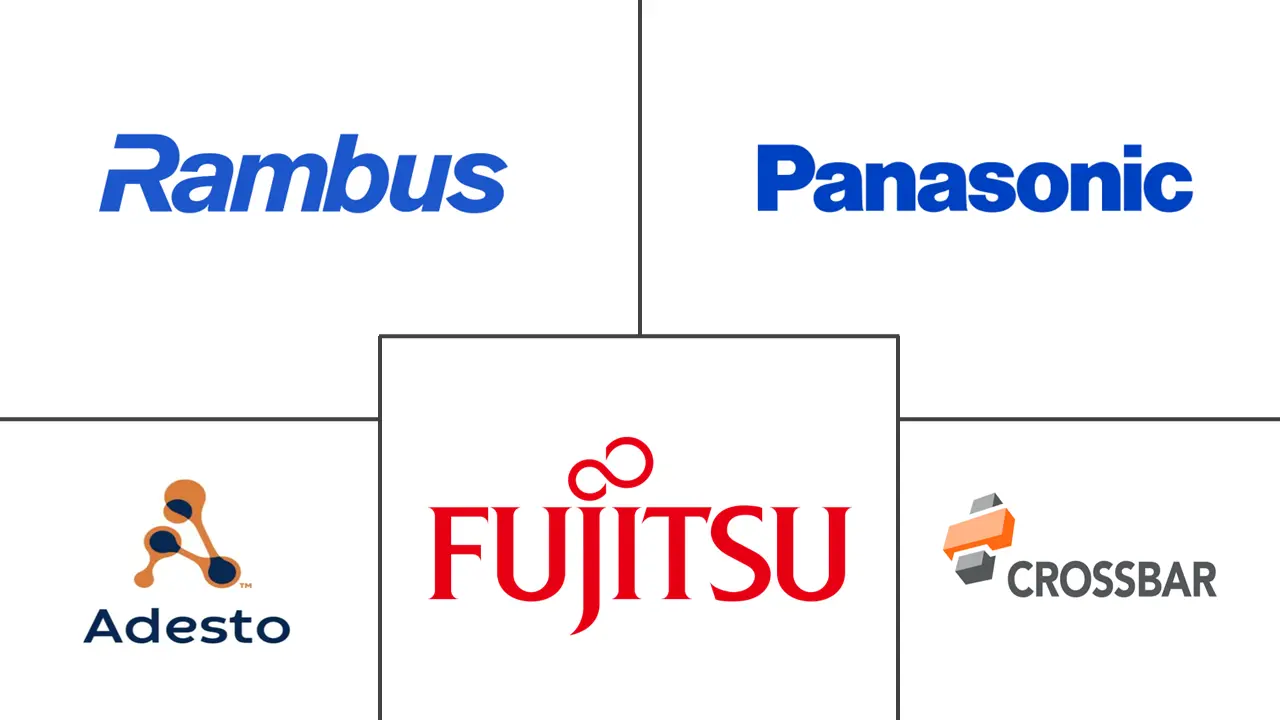Market Size of Resistive RAM Industry

| Study Period | 2019 - 2029 |
| Base Year For Estimation | 2023 |
| CAGR | 29.90 % |
| Fastest Growing Market | Asia Pacific |
| Largest Market | North America |
| Market Concentration | Medium |
Major Players
*Disclaimer: Major Players sorted in no particular order |
Resistive Random Access Memory (RAM) Market Analysis
The Resistive RAM market is expected to register a CAGR of 29.9% over the forecast period. Resistive RAM, a non-volatile memory, is anticipated to seize a market share by substituting static random-access memory and dynamic random-access memory. The replacement will be possible due to numerous benefits given by resistive random-access memory, such as large storage density and 3D packing, allowing layers of memory gadgets to be coordinated and organized in one chip, fast switching for quick exchange of information, and using less energy per switching cycle. ReRAM also can replace flash memory used in mobile phones and other consumer electronics such as MP3 players.
- Further, the growing adoption of sensor technology, such as wearable and AI-enabled devices in various regions throughout the world, has boosted the demand for fast data transfers and high storage density, which in turn is providing a tremendous chance or possibility for the growth of the resistive random access memory market globally.
- Moreover, various multiple memory companies are investing in ReRAM technology. For instance, in April last year, CrossBar Inc., a non-volatile memory technology provider, announced new applications of its ReRAM technology for usage in secure storage and processing, where resistance to reverse engineering and physical attacks is an essential requirement of the system. The company's technology is now being offered for use in memory applications requiring higher levels of content security.
- Resistive random-access memory (ReRAM) is gaining traction as non-volatile memory (NVM) alternative, particularly in cloud and data center contexts where performance and energy efficiency are constantly improving. ReRAM technology has demonstrated lower read latency and quicker write version than flash memories while also achieving 64pJ/cell program energy, which is a 20% improvement over NAND, as the demand for data grows from users through premium services such as video streaming and from machines through the Internet of Things (IoT). In addition, the 3D vertical ReRAM arrays provide high-performance memory subsystems capable of replacing standard DRAM- or flash-based SSDs in data center environments, allowing faster data processing, storage, and retrieval in significantly smaller form factors with lower energy consumption.
- However, the soaring costs of resistive random-access memory and the complexity in various technological applications have become crucial challenges that can hinder the market's growth throughout the forecast period.
- Moreover, the COVID-19 pandemic is likely impeding the overall anticipated growth of the market, mainly attributed to the supply chain disruption, with several companies witnessing a scarcity of components like inductors and capacitors for manufacturing. But over the subsequent years, the innovation and implementation of new materials are expected to boost the demand for resistive random access memory in diverse verticals throughout the world.
Resistive Random Access Memory (RAM) Industry Segmentation
Resistive random access memory(ReRAM or RRAM) is a non-volatile random access computer memory that operates on the principle of changing the resistance over a dielectric solid-state material. Resistive random access memory is based on applying the memory function by changing the material's resistance between a high and low state.
The Resistive RAM Market is segmented by Application (Embedded, Standalone), End-user (Industrial/IoT/Wearables/Automotive, SSD/Datacenters/Workstations), and Geography (Americas, Europe, China, Japan, Asia-Pacific ((excl China and Japan)). The market sizes and forecasts are provided in terms of value (USD million) for all the above segments.
| Application | |
| Embedded (Analog ICs, MCU/SoC/ASIC/ASSPs, In-Memory Computing) | |
| Standalone (Fast/Reliable Memory, Code/Data Storage, Low-latency Storage and Persistent Memory) |
| End-user | |
| Industrial/IoT/Wearables/Automotive | |
| SSD/Datacenters/Workstations |
| Geography | |
| Americas | |
| Europe | |
| China | |
| Japan | |
| Asia-Pacific (excluding China and Japan) |
Resistive RAM Market Size Summary
The Resistive RAM market is poised for significant growth, driven by its potential to replace traditional memory technologies like static and dynamic random-access memory, as well as flash memory. This non-volatile memory technology offers advantages such as high storage density, 3D packing capabilities, rapid switching speeds, and lower energy consumption, making it an attractive option for applications in mobile phones and consumer electronics. The increasing demand for fast data transfers and high storage density, fueled by the adoption of sensor technologies in wearable and AI-enabled devices, presents a substantial opportunity for the market's expansion. Companies are actively investing in ReRAM technology, exploring its applications in secure storage and processing, which are crucial for systems requiring resistance to reverse engineering and physical attacks.
The market's growth is further supported by the rising demand for interconnected devices and the development of smart cities and homes, which necessitate robust memory capacity servers. Resistive RAM's superior performance in read-intensive applications and its suitability for industrial, automotive, and IoT sensor devices underscore its potential. The Asia Pacific region, particularly China, South Korea, and India, is expected to play a pivotal role in the market's expansion due to the burgeoning consumer electronics and automotive industries, along with the establishment of data centers. Despite challenges such as high costs and technological complexities, the market is anticipated to benefit from innovations and new materials, with major players like Rambus Inc., Panasonic Corporation, and Fujitsu Ltd. actively enhancing their production capacities and strategic collaborations to capture a larger market share.
Resistive RAM Market Size - Table of Contents
-
1. MARKET INSIGHTS
-
1.1 Market Overview
-
1.2 Industry Attractiveness - Porter's Five Forces Analysis
-
1.2.1 Bargaining Power of Suppliers
-
1.2.2 Bargaining Power of Consumers
-
1.2.3 Threat of New Entrants
-
1.2.4 Threat of Substitute Products
-
1.2.5 Intensity of Competitive Rivalry
-
-
1.3 Industry Value Chain Analysis
-
1.4 Assessment of the Impact of COVID-19 on the Industry
-
-
2. NVM MARKET OVERVIEW - Providing coverage for overall NVM (non-volatile memory) shipments. Shipments will be provided in terms of the number of equivalent 12-inch wafers, along with major trends and recent developments, etc.
-
3. MARKET SEGMENTATION
-
3.1 Application
-
3.1.1 Embedded (Analog ICs, MCU/SoC/ASIC/ASSPs, In-Memory Computing)
-
3.1.2 Standalone (Fast/Reliable Memory, Code/Data Storage, Low-latency Storage and Persistent Memory)
-
-
3.2 End-user
-
3.2.1 Industrial/IoT/Wearables/Automotive
-
3.2.2 SSD/Datacenters/Workstations
-
-
3.3 Geography
-
3.3.1 Americas
-
3.3.2 Europe
-
3.3.3 China
-
3.3.4 Japan
-
3.3.5 Asia-Pacific (excluding China and Japan)
-
-
Resistive RAM Market Size FAQs
What is the current Resistive RAM Market size?
The Resistive RAM Market is projected to register a CAGR of 29.90% during the forecast period (2024-2029)
Who are the key players in Resistive RAM Market?
Panasonic Corporation, Adesto Technologies, Fujitsu Ltd, Crossbar Inc. and Rambus Inc. are the major companies operating in the Resistive RAM Market.

